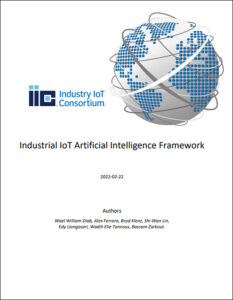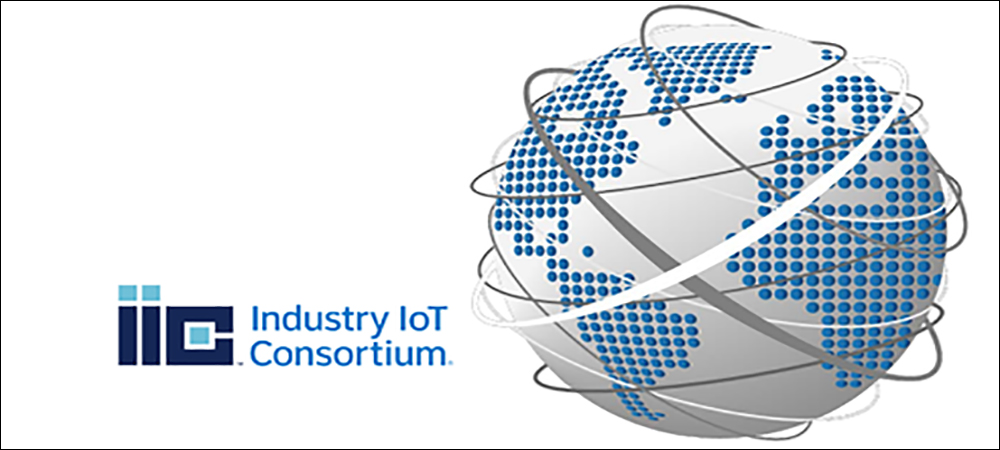Internet of Things (IoT) technology users face the challenge of managing the data they collect, and many are thus turning to artificial intelligence (AI). However, guidelines for how IoT adoption should be managed, as well as the key concerns regarding AI use, are limited. With that in mind, the Industry IoT Consortium (IIC) has published a document to serve as a blueprint for industrial company decisions makers, explaining how to use AI as part of an IoT solution. The report is titled “Industrial IoT Artificial Intelligence Framework” (IIAIF).
The IIAIF report highlights the value proposition AI can enable in next-generation Industrial Internet of Things (IIoT) systems, while examining emerging requirements and offering key points to serve as guidance. The IIC intends the framework to help users of IIoT technologies extend their deployments and further leverage and benefit from the data being captured across the business, as well as a company’s IT and operational technology sectors. Released in March, the report is intended to accelerate the responsible adoption of AI-enabled IIoT systems and bring the benefits of digital transformation to more use cases and sectors, according to Wael William Diab, the chair of the organization’s Industrial AI Task Group, which developed the IIAIF.
 Industrial AI is converging with the IIoT in areas like smart manufacturing, robotics, predictive maintenance, the diagnosis of infectious disease via machine learning, and autonomous vehicles. Where companies gather sensor data, AI can help them to extract learning and measurements from that information. The IIC has been providing technical support for industry related to IIoT technology since 2014, says Bassam Zarkout, the IIAF’s chief editor and co-author, as well as the executive VP of IGnPower.
Industrial AI is converging with the IIoT in areas like smart manufacturing, robotics, predictive maintenance, the diagnosis of infectious disease via machine learning, and autonomous vehicles. Where companies gather sensor data, AI can help them to extract learning and measurements from that information. The IIC has been providing technical support for industry related to IIoT technology since 2014, says Bassam Zarkout, the IIAF’s chief editor and co-author, as well as the executive VP of IGnPower.
This year, Zarkout says, “With the framework, we’re really looking at the intersection of AI and Industrial IoT.” From a business perspective, he explains, the framework is focused on maximizing value through a direct return on investment, such as better use of labor, as well as capital and indirect societal gains. Examples of the latter, he notes, include disease diagnosis, disaster prediction and education.
For AI adoption, Zarkout says, there are barriers for companies to overcome, centered around ethical considerations such as bias or eavesdropping that have concerned potential users and the public in the past. He adds that users must build their domain and use cases specific to concerns around these issues, as well as safety. In fact, he says, “It may be unethical not to use AI in certain use cases”—for instance, accelerating research and development, such as finding a cure for a pandemic.
On an IT level, the framework looks at architecting, integrating and deploying the technology, how to achieve intended organizational goals, and how to monitor effectiveness once the technology is deployed. That, Diab says, requires a balance of architecture, implementation and resources. From a usage perspective, the report demonstrates that responsible adoption of an AI system ensures confidence in it. Additionally, he says, “AI can be a force for good when discussing confidence and ethics.”
The ethical side of an AI deployment is considered within the framework, Diab says. For instance, artificial intelligence can have an inherent bias or impinge on privacy by eavesdropping, so those concerns need to be anticipated and addressed, then managed by the company using the system. “If you look at enough data going back long enough,” he states, “you will have some systemic biases that we would not want to see today.” These include looking at all data equally, whereas a human would know that such an approach introduces inequality in some cases.

Wael William Diab
Examples of AI with IIoT systems include managing data from connected devices to track predictive maintenance. Artificial intelligence can measure and compare sensor data from each piece of equipment or component within a factory, providing more detailed information and analytics than standard IIoT systems might offer.
With regard to healthcare, AI can be used for medical diagnostics with image analytics coming from device data. Solutions using AI and IIoT technologies can predict the needs of hospital equipment and supplies, provide predictive maintenance for medical equipment, diagnose dementia based on patients’ behavior, or streamline patient registration and onboarding processes. An AI-enabled patient-diagnostic system could remotely monitor patients’ health information transmitted by wireless wearable devices. AI technology could also be used for energy management in buildings, or to make warehouse automation and management faster and more precise.
In addition, AI could detect threats to an IIoT system by recognizing unauthorized devices that could, for instance, be collecting data surreptitiously. Diab foresees technologies such as IoT, AI and digital twins coalescing into solution ecosystems. In the meantime, he says, many companies are leveraging disparate technologies or siloed systems, such as IoT without AI. “So we’re trying to target decision makers,” he states, while looking at the challenges of adopting solutions from a variety of perspectives.
“The art of what AI can do is continuously advancing,” Zarkout states, “and at some point, the quality of the insight that’s provided by the AI—and the speed with which this insight can be generated—will surpass that of humans.” At that point, he predicts, AI will accomplish tasks faster and more reliably. “So at some point, you will really have to ask yourself, ‘Why am I not choosing AI?'” Using healthcare as an example, he adds, “‘Why am I not choosing AI in X-ray analysis for cancer treatment?’ It can do so faster better than most humans. We are slowly but surely approaching or even passing that point when AI will become the norm.”

Bassam Zarkout
The IIoT can help users determine why plant A is producing better than plant B, or why it is experiencing fewer breakdowns. Introducing AI can provide richer data and analytics. For example, humidity readers that are different at one factory than at another could be a key indicator of a problem that AI is designed to detect and manage.
“I believe companies [using IIoT technology] would benefit tremendously from AI implementations,” Diab states, “simply because AI allows you to cross that divide between the IT world and the OT world and extract insight by recognizing patterns across the two environments.” Part of the current digital transformation trend, he adds, “is not just getting into new sectors or verticals. It’s getting deeper, so it’s the idea that you get more and more insights, earlier on or further up in the decision-making process.”
The framework follows a similar report for IIoT architecture and technology use. IIC members held a combination of internal panels in which members could participate, and that formed the major plan. The framework was built with the support of a diverse set of members and stakeholders, Diab says, including companies ranging from small to large in size. “We look at this as a Google Maps, as opposed to a TripAdvisor,” Zarkout says, to help users plan their own journey based on its guidance. “We’re not necessarily providing a guided tour and step-by-step instructions.”
In the face of accelerating technology development, including AI, Diab says, “I think we’re very lucky to be living during this time, with the rapid evolution that’s happening with the technology.” He adds, “The point here is to start people along the journey of understanding what the next-generation Industrial IoT systems are, and specifically what’s happening when you integrate AI.” The IIAIF report is available online, and the group is accepting new members with IIoT interests.
Exhibitors at RFID Journal LIVE! 2022 will offer Industrial Internet of Things solutions. To learn more, visit the event’s website.


